Week 29: A Brief History of Heart Rate Variability-Guided Training
Origins, evidence and current recommendations for HRV-guided training
Hi there 👋
I hope you are doing well.
I’ve recently shown a simple case study for HRV-guided training, which you can see here. In this blog, I cover the origins, research, and what would be my recommendations for people interested in using this approach to better balance training and other stressors.
The goal of HRV-guided training is to deliver the right training stimulus at the right time. In practice, this means introducing stress when your body is primed to handle it, maximizing the chances of positive adaptation and long-term performance gains. We all intuitively know that timing matters; some days we’re ready to push, and others we’re not. HRV provides a way to measure these fluctuations and fine-tune the timing of demanding sessions, like when to schedule a hard workout.
At its core, HRV is simply an indirect marker of cardiac vagal tone, which reflects your body’s current physiological stress state. This insight, however, is only reliable when HRV is measured correctly, following established best practices. Perhaps most importantly, HRV can bring an added layer of awareness: blending subjective perception with objective data to make smarter, more informed decisions about your training and recovery.
Below, we’ll see how the data has been used in landmark studies, as well as how I’d recommend using it today.
The Origins
A pivotal study by Kiviniemi et al. (2007) introduced one of the first structured protocols for HRV-guided training. The researchers compared changes in training load and VO₂max in recreational runners who followed either an HRV-based program or a traditional periodized plan.
The core principle was straightforward: reduce training intensity when HRV dropped, and maintain or increase intensity when HRV stayed stable or improved. To implement this, the authors adopted an “acute change” approach. HRV was measured daily at home using high-frequency (HF) oscillations of RR intervals, a marker of parasympathetic activity, conceptually similar to rMSSD (see my breakdown of different HRV indices, here).
Here’s how it worked:
If HRV increased or remained unchanged, athletes performed a high-intensity workout.
If HRV significantly declined, athletes switched to low-intensity training or complete rest.
The threshold for a “significant decrease” was defined as a daily HRV value falling at least one standard deviation below the individual baseline (calculated over 10 days) or a downward trend persisting for two consecutive days.
Below is an image I created to highlight how the approach would work, showing in red the days in which lower intensity training or rest would be prescribed.
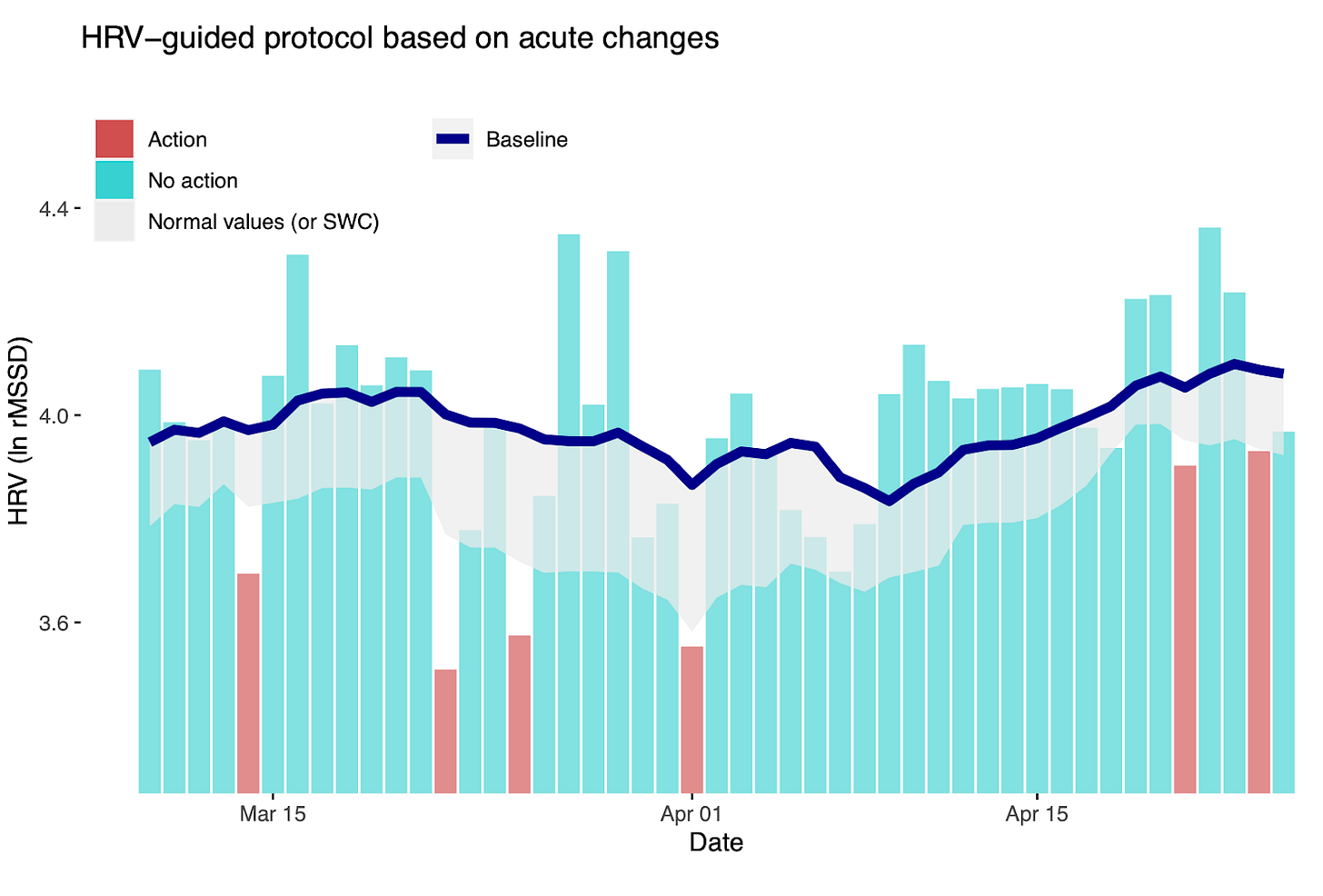
As it often happens with HRV-guided studies, the group using this approach trained less at high intensity, but had better outcomes. This is a common theme in HRV-guided training, as most protocols aim at avoiding the application of a strong stressor when the athlete is not physiologically ready to assimilate it.
Keep in mind that a low HRV does not mean that the athlete would not be able to execute a hard session, but that hard stimulus may not be absorbed by the athlete as effectively. Something I’ve discussed also here.
The Big(ger) Picture
After the early work by Kiviniemi et al., research gradually moved away from focusing on day-to-day fluctuations and short-term stressors. Instead, attention shifted toward medium- and long-term trends, emphasizing the cumulative effects of training and recovery on performance and overall health. Researchers such as Buchheit and Plews popularized the use of 7-day moving averages (the baseline) combined with the smallest worthwhile change (SWC), what we often refer to as the athlete’s “normal values.”
The reasoning behind this shift is that a baseline average offers a more stable picture of physiological status compared to a single daily measurement. This approach helps prevent overreacting to normal variability, which can be influenced by minor or transient stressors. In practice, this means we now respond primarily to meaningful, sustained changes, rather than a single low HRV reading. Only a series of suppressed scores (or a very large drop caused by illness or severe stress) will pull the baseline below the normal range.
Here’s how it works:
Baseline: calculated over about 7 days.
Normal range: typically based on 1–2 months of data.
For the baseline to dip below normal values, it usually requires multiple consecutive low days or extremely low HRV values. This ensures that adjustments are made only when the body is truly under significant stress, not just because of normal daily variability.
This approach was tested in studies similar to the one of Kiviniemi, looking at performance or physiological changes in groups of runners and cyclists, by Vesterinen, Javaloyes and others. The updated protocol recommends low-intensity work or rest when the baseline falls outside of the normal range, whether below or above.
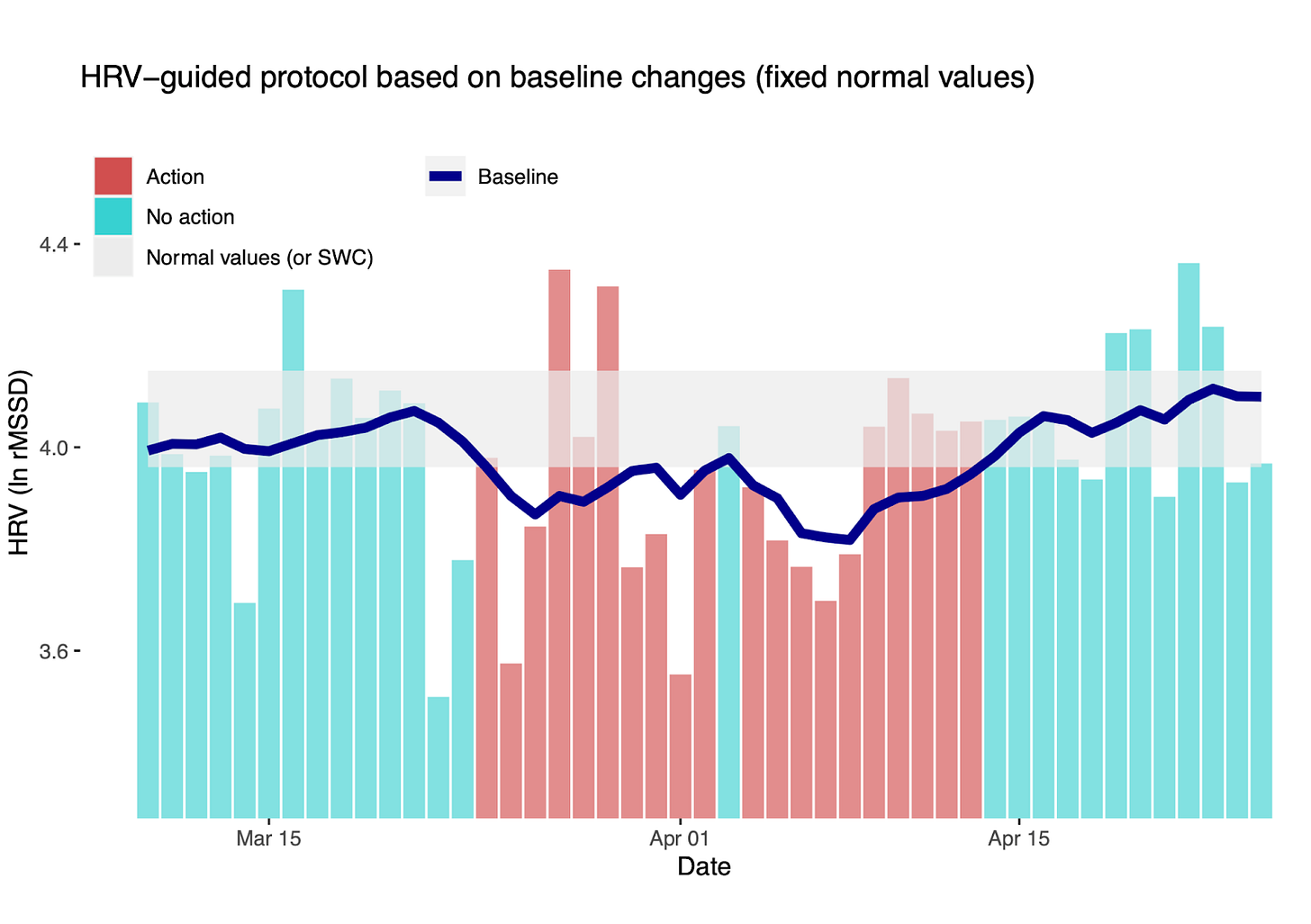
This represents an important conceptual shift. In the original Kiviniemi et al. approach, a higher HRV score was always interpreted as positive. The newer model prioritizes stability within normal limits, echoing the principles I discussed many times: in physiological monitoring, “normal” is generally a sign of balance and resilience. Outliers, whether high or low, warrant caution.
Why? Statistically, deviations from the norm indicate abnormality. Physiologically, they often signal stress or maladaptation. As Vesterinen notes, when HRV drops below the normal range, it reflects reduced vagal tone and elevated sympathetic activity, common after periods of heavy training and a sign of incomplete recovery.
Conversely, as Le Meur et al. (2013) observed, abnormally high HRV can indicate parasympathetic hyperactivity, sometimes linked to functional overreaching or even overtraining.
In both cases, backing off intensity is a smart choice.
Since these first studies pioneering studies, more literature has shown similar results, including reviews highlighting how an HRV-guided approach might be beneficial to improve performance or physiological surrogates of performance (Düking, Zinner, and Reed 2020; Carrasco-Poyatos et al. 2022; Javaloyes et al. 2020; Nuuttila et al. 2017).
Recommendations
While my work primarily emphasizes resting physiology, there are other important metrics worth monitoring. In particular, subjective indicators, such as mood, fatigue, and muscle soreness, provide valuable context, capturing elements of the training response that resting heart rate or HRV alone may miss.
For instance, muscle soreness is a key marker of recovery and adaptation, yet it’s not reflected in HRV or heart rate (which also makes it pretty clear that it is pointless to pretend to capture ‘recovery’ or ‘readiness’ the way wearables do). Collecting this data is however very simple, you just have to ask your athletes, or use questionnaires integrated into HRV apps like HRV4Training.
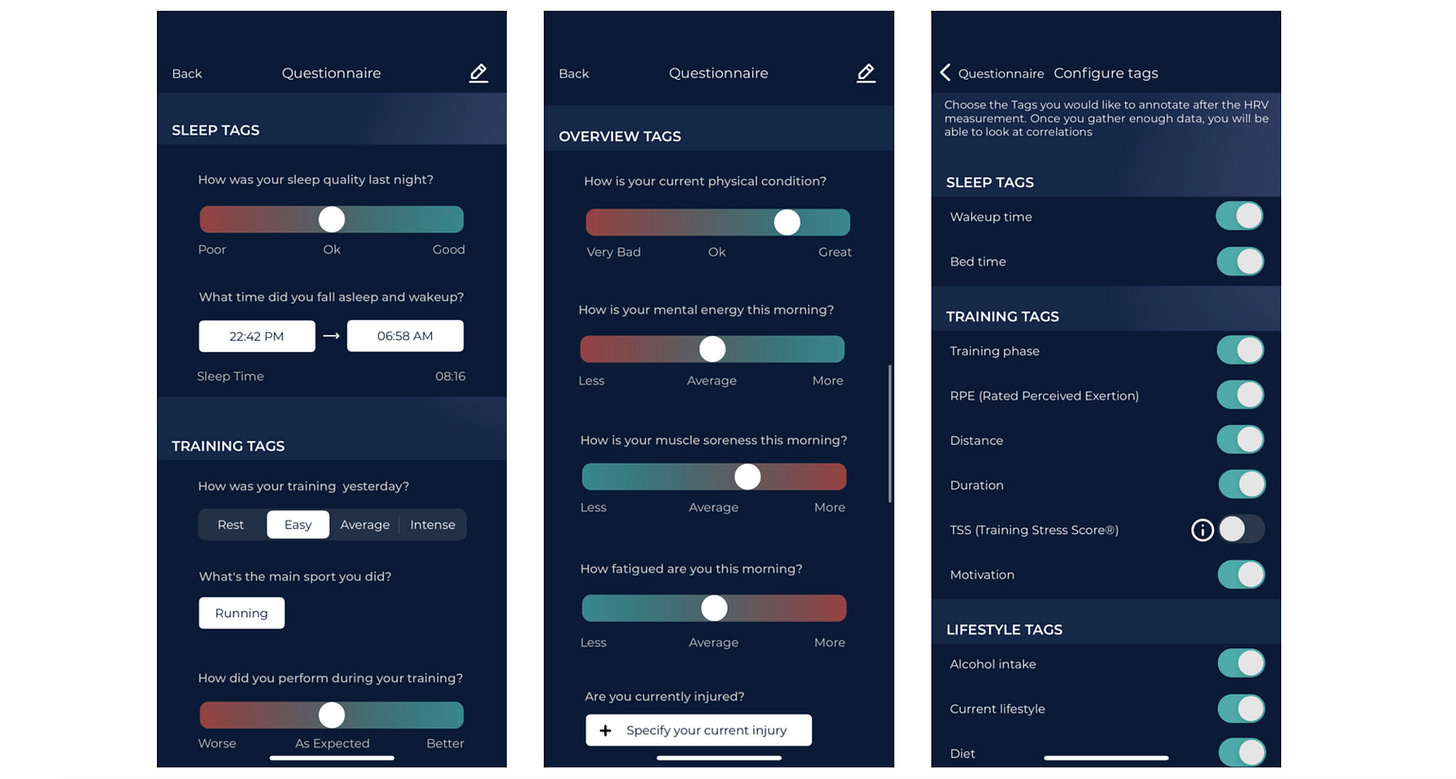
To build a more complete picture, we can combine resting physiology, subjective feedback, and training data. This approach was explored in a recent study that personalized training decisions based on all three dimensions, rather than HRV alone (Nuuttila et al., 2022). The findings were clear: while traditional periodization improves performance on average, individualized methods reduced the risk of athletes showing little progress and increased the chance of a strong response.
This, to me, reflects the core of true individualization: helping every athlete improve, rather than relying on group averages.
This is also the approach I use with the athletes I coach, looking at acute and chronic changes in resting physiology, assessing changes in exercise physiology (e.g. internal vs external load, as shown here, or in their performance for certain key sessions) and combining all of this data with subjective feedback on daily sessions as well as the parameters tracked in the morning questionnaire in HRV4Training.
That’s all for today, thank you for reading!

Discount for HRV4Training Pro: 20% off 🖥️
HRV4Training Pro is the ultimate platform to help you analyze and interpret your physiological data, for individuals and teams.
You can find a guide and overview here.
Try HRV4Training Pro for free at HRVTraining.web.app or use promo code SCIENCE for 20% off.
While we really appreciate the pledges on Substack, our writing here will always remain free, and Pro is the best way to support our work.
I thank you for that.
When using Pro, the app will also automatically recognize your account and add the Normal Range to the Baseline view, together with detected trends and additional annotations, which can help contextualizing longer-term changes.
You will also be able to pick rMSSD as the parameter to see on the homepage of the app.
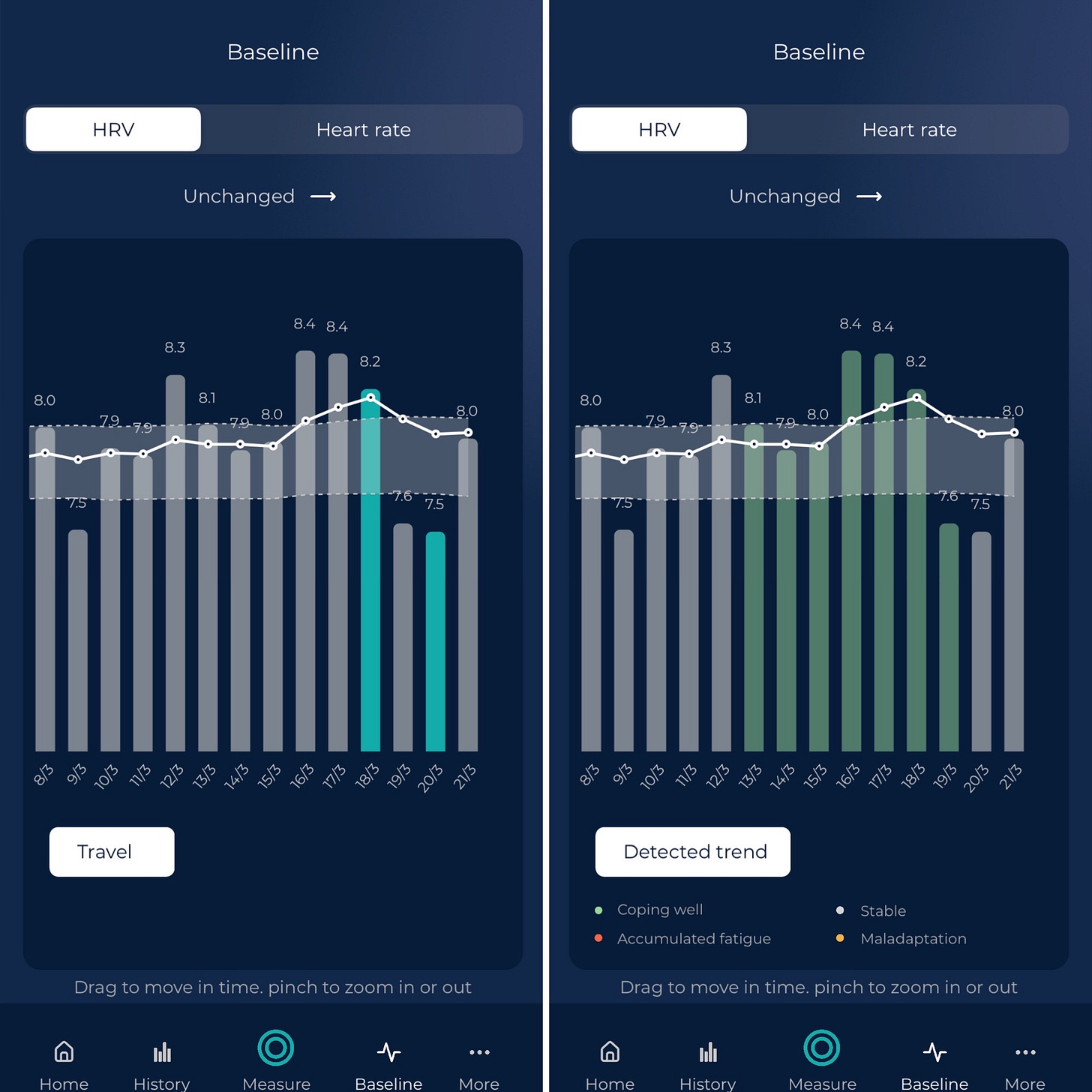
See you next week!
Marco holds a PhD cum laude in applied machine learning, a M.Sc. cum laude in computer science engineering, and a M.Sc. cum laude in human movement sciences and high-performance coaching. He is a certified Ultrarunning Coach.
Marco has published more than 50 papers and patents at the intersection between physiology, health, technology, and human performance.
He is co-founder of HRV4Training, Endurance Coach at Destination Unknown, advisor at Oura, guest lecturer at VU Amsterdam, and editor for IEEE Pervasive Computing Magazine. He loves running.
Social:






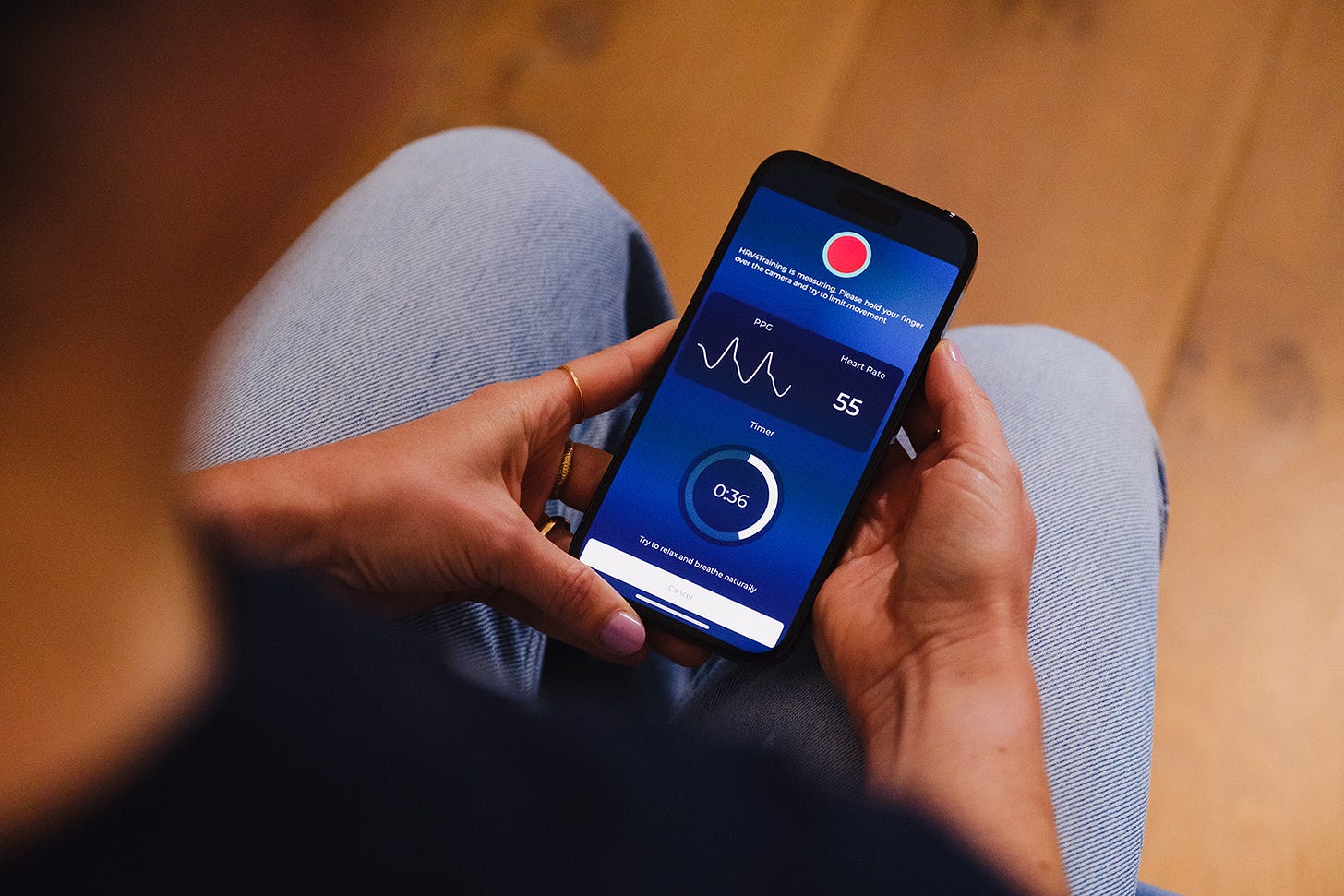
Hi Marco, love your app - one challenge though - does it sync with Android's Health Connect?